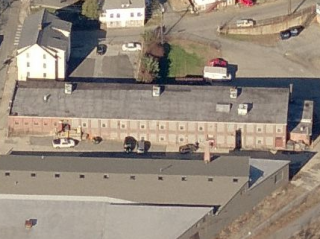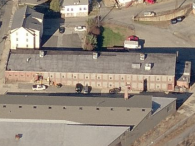Mill Record Windham
RETURN TO ‘FIND MILLS’Disclaimer: Content for these properties was compiled in 2014-2017 from a variety of sources and is subject to change. Updates are occasionally made under Property Information, however the Connecticut Trust for Historic Preservation (dba Preservation Connecticut) makes no representation or warranty that the information is complete or up-to-date.
- Complex Name (Common)
- Willimantic Machine Co.
- Complex Name (Historic)
-
- Willimantic Machine Co.
- Address or Location
- 95 Milk Street, Willimantic, Windham
- County
- Windham
- Historic Designation
- Associated Mill Community
- n/a

- Historic Information
Companies Associated w/Complex
- Atwood Machine Co. ca. 1916-ca. 1932
- Roselin Mfg. Co. 1935-late-20th c.
- Willimantic Machine Co. 1910-ca. 1916
Use (Historic)
Largest Documented Workforce
10-24 (1939).
Historic Narrative
The Willimantic Machine Company was incorporated by George E. Stiles, E. Harlowe Holmes, and Charles E. Leonard, all residents of the Willimantic section of Windham, Connecticut, on June 20, 1899. Established with $15,000 in capital, the firm manufactured machinery used by textile and thread producers. Much of this was purchased and employed locally by notable Willimantic firms such as the American Thread Company. The Willimantic Machine Company initially rented small shops on Valley and North Streets in Willimantic, before a dedicated plant was erected on Milk Street in 1910. Around 1916, control of the Willimantic Machine Company was acquired by the Atwood Machine Company of Stonington, Connecticut. This firm operated the shop as a branch location until ca. 1932, whereupon work ceased and the factory fell silent. In 1935, the plant was purchased by the Roselin Manufacturing Company, a New York-based textile firm specializing in cotton and rayon braiding and ribbon that was moved to Willimantic by its president, Isadore Rosenstein. The Roselin Manufacturing Company also occupied the former S.C.S. Box Company plant just to the northeast on Moulton Court and both factories were heavily damaged during the Hurricane of 1938. The upper story of the Milk Street building was blown in and not replaced when repairs were made following the storm. The Roselin Manufacturing Company continued to operate into the late 20th century, with Mitchell Rosenstein, the son of Isadore Rosenstein continuing to serve as president until his retirement in 1989.
- Architectural Information
Number of Existing Buildings
Two (2) adjoining blocks.
Dates of Construction
1910.
Architect
n/a
Builder
n/a
Building Type
Architectural Description
The former Willimantic Machine Company plant is comprised of two adjoining blocks located on the east side of Milk Street, roughly 100’ south of Milk Street’s intersection with Moulton Court. Both blocks were erected in 1910 and are of brick pier construction. The main manufacturing block stands one story tall along its frontage on Milk Street yet is effectively two stories in height at the eastern (rear) end of the building due to the grade of the parcel. The block measures 50’ x 226’ overall and has red brick walls, segmental-arched window openings with stone sills, a stepped parapet with concrete copings, and a low-pitch front-facing gable roof. The primary entrance is located on the west elevation facing Milk Street and consists of a segmental-arched opening with concrete stairs, a stone threshold, and a rectangular transom above the door. The rear block was built to house the factory’s boiler plant. It adjoins the main building’s east elevation and stands one-story tall. The building measures 41’ x 20’ overall and has a shed roof. The details are similar to those employed in the manufacturing block.
Exterior Material(s)
Structural System(s)
Roof Form
Roof Material
Power Source
Condition
Fair
Condition Notes
The complex is in fair condition. The majority of the original window openings have been reduced in size using concrete block masonry units and new fenestration has been installed, however, overall, the plant is well maintained and appears sound.
- Property Information
-
Specific Location
One legal parcel (95 Milk Street) totaling 0.58 acres located on the east side of Milk Street, roughly 100’ south of Milk Street’s intersection with Moulton Court.
Adjacent To
Exterior Visible from Public Road?
Yes
Parcel ID / Assessor Record Link
- 14-3/108/15A (for record, use link and type in address or parcel number) / Link →
Acreage
0.58
Use (Present)
- Sources
-
Form Completed By
Lucas A. Karmazinas
Date
08/13/2015
Bibliography
- List of Connecticut Manufacturers, 1922, 1924, 1930, 1932.
- Directory of Connecticut State Manufacturers, 1936, 1939.
- Industrial Directory of Connecticut, 1947.
- Register of War Production Facilities in Connecticut, 1951.
- Map of Windham County; E.M. Woodford, 1855.
- Atlas of Windham County; O.W. Gray, 1869.
- Sanborn Map Company, 1908, 1914, 1924, 1948.
- Hartford Courant, 1899, 1910, 1913, 1915, 1995.
- A History of Windham County, Connecticut; Bayles, Richard M., ed., 1889.
- A Modern History of Windham County, Connecticut; Lincoln, Allen B., 1920.
- Representative View(s)Click on image to view full file






